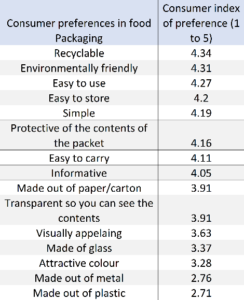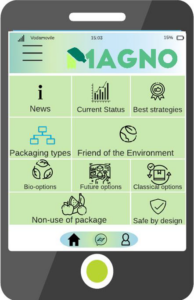MAGNO Consumer Acceptance Tool: Context

Customers do not buy packaging directly; rather, they buy food goods that include packaging as part of the offer. Consequently, while investigating the influence of food packaging on consumer food selection, it is essential to focus on how packaging alters the value equation for the food products themselves. One of the primary drivers of consumers’ perceptions on food quality is product presentation. Because of this, the consumer plans (decisions and intentions) are affected considerably by the packaging-related product characteristics. In this sense, packaging is incorporated into a food product as a technique to deliver functional benefits such as to safeguard products against harm, provide essential information, market the product, and enhance storage efficiency . Although customer perception and production costs for products and packaging are seen as two of the most significant factors governing the deployment of new product technologies, there is a lack of research concerning public acceptability of packaging systems. As a result, citizen science tools are crucial in the participation of the general people (consumers) in the scientific process of analysing and reporting preferences and behaviours. Only a few studies have explored consumer preferences for food packaging demonstrating that recyclable packaging is favoured over traditional plastic packaging (see Table below). It is clear that the modern consumer is looking for the simplest solution with the lowest environmental impact. Moreover, public participation, especially in environmental science programs, can have a positive social and environmental impact by enabling citizens to reconnect with nature, form social relationships, raise awareness, enhance knowledge, alter their behaviours and advocate for political change.
MAGNO C onsumer Acceptance Tool: Plans
onsumer Acceptance Tool: Plans
MAGNO will create a web platform (Figure below) dedicated to increasing consumer acceptance, and integrating news, statistics and recommendations for best packaging practices. The main goals of implementing this consumer accept
ance platform are:
i) to demonstrate the potential reduction of plastic packaging pollution when multi-actor strategies are adopted by showcasing all project results,
and ii) to create an environment in which innovation reaches society by incorporating the user in an engaging manner into the packaging value chain.
The target audience of the platform is the general consumer, but it also will include information for different actors in the food packing sector. It will include a userfriendly interface which highlights the project outcomes (e.g., showing different packaging solutions and how they impact on the environment and human health, promoting non-use of packaging whenever possible). In addition, results and simulations pertaining to the implementation of sustainable packaging systems will also be presented in an appealing/friendly manner. Furthermore, the platform will also display the outcomes of any possible optimisation for different scenarios generated by the Ecosystem Digital Twin, contributing directly to the enhancement of the EU’s standing.
Reference:
68 Erin, Y., et al. Front. Sustain. Food Syst., 4, Sec. Sustainable Food Processing, 2020.
69 Shahida, A., et al. LWT, 172, 30, 2022.
70 Robertson, L., et al. Food Packaging Principles and Practice, CRC press, 2013.
71 6 Required Functions of All Product Packaging [accessed on February, 2023]
72 Popa, C., et al. Sustainability 2022, 14, 13265.
73 Linda, B., et al. Consumer Acceptance of Packaging Design Alternatives: Survey Data Set. Technical Report. 2022
74 Chiara C., et al. Foods 2022, 11, 2388.
75 Norton, V., et al. Foods 2022, 11, 3424.
76 Giovanni, S., et al. Marine Pollution Bulletin, 185(A), 2022.